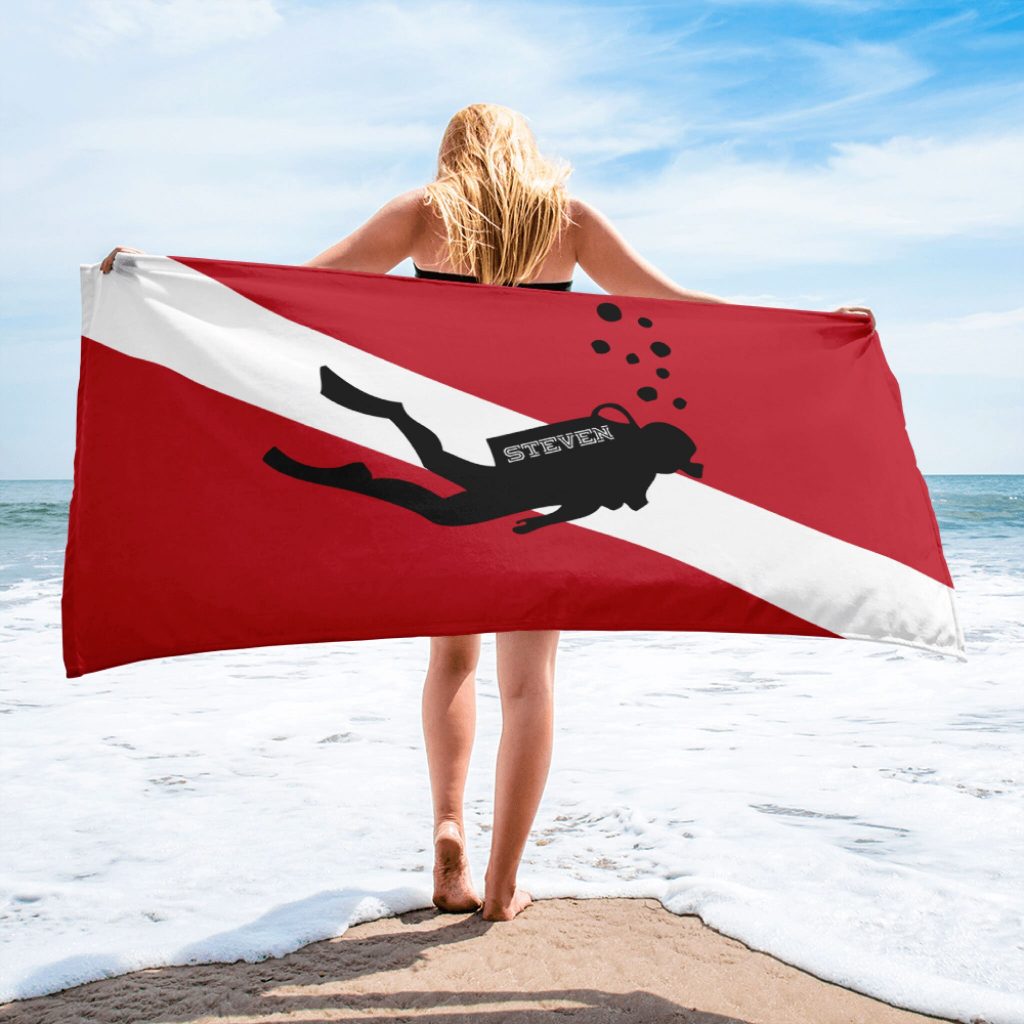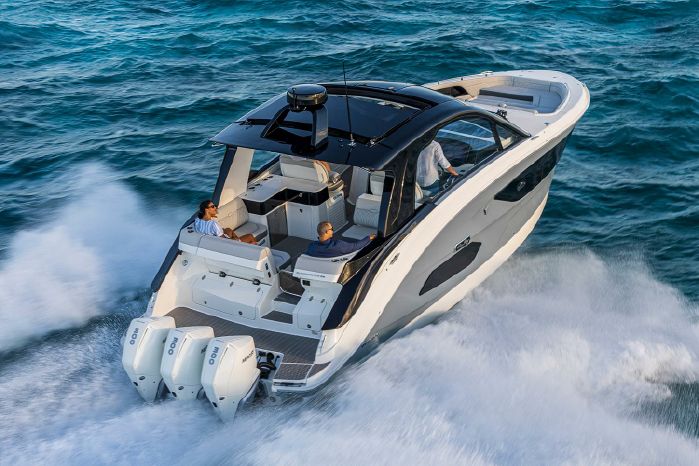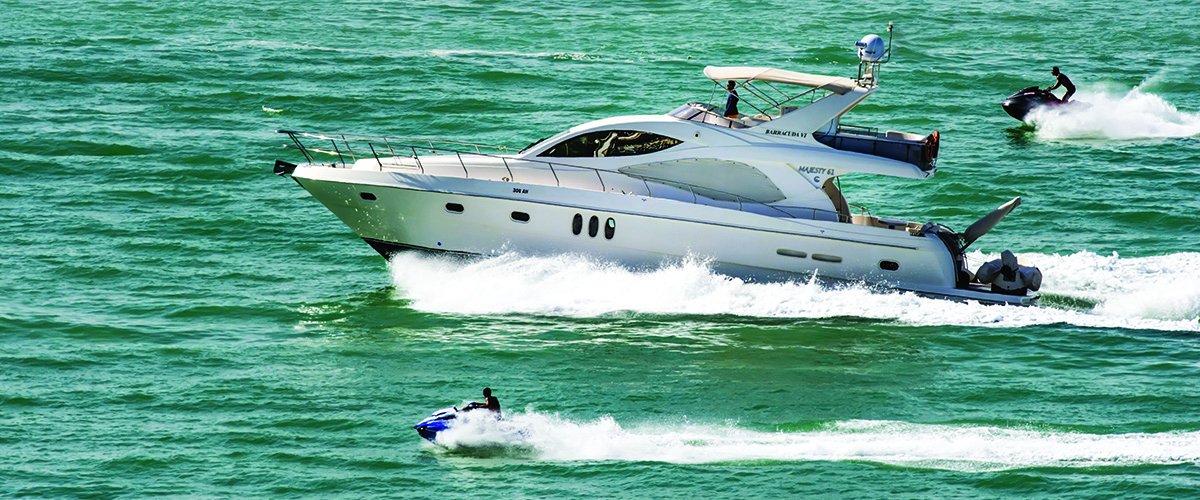Which of the Following Accurately Describes the Two Types of Diver-Down Flags? A Comprehensive Guide
Diving is a popular recreational activity, but also poses certain risks to both divers and boaters in the surrounding waters. One essential safety measure in place to protect divers is the use of diver-down flags.

There are two types of diver-down flags that indicate the presence of a submerged diver or diving activity in the area. Familiarizing oneself with these flags is crucial for divers, boat operators, and other water users to ensure everyone's safety on the water.
The first type of flag is the red and white divers flag, which is rectangular with a white diagonal stripe. The second type is the blue and white International Code Flag A, also known as the Alfa flag.
Both flags serve the same purpose - to warn nearby boats that there is a diver in the water and that they should steer clear and maintain a slow speed to prevent accidents or endangering the diver. Understanding, recognizing, and abiding by these flag signals are not only essential for safety but may also be required by law in different jurisdictions.

Key Takeaways
- Two types of flags, the red and white divers flag and the blue and white Alfa flag, help ensure diver safety by warning nearby boats of their presence.
- Familiarity with these flag signals is crucial for divers, boat operators, and water users to maintain safety and comply with potential legal requirements.
- Respect for diver-down flags and adhering to safety protocols can prevent accidents and ensure a positive experience for all water users.
Diver-Down Flag Basics
Definition and Purpose
Diver-down flags are essential safety tools for scuba divers and snorkelers in the water. Their main purpose is to inform nearby boaters and watercraft operators of the presence of divers below, indicating that they should exercise caution and maintain a safe distance from the flag to avoid potential accidents. These flags are typically displayed on boats, buoys, or float lines to mark the diving area.
The Two Types of Flags
There are two types of diver-down flags that are widely recognized and used around the world: the Alpha flag and the Red flag. Each flag has its own distinctive design and communicates specific information to those in the vicinity.
- Alpha flag: The Alpha flag, also known as the "blue and white flag," is internationally recognized and used during diving activities. This flag design features a white and blue color scheme, with the white section forming a diagonal line across the flag. The Alpha flag signals, "I have a diver down; keep well clear at slow speed" (source).
- Red flag: The Red flag, or "diver down flag," is predominantly used within the United States and has a red rectangular design with a white diagonal stripe running from the top left to the bottom right. This flag also indicates the presence of a submerged diver in the area and advises boats to maintain a safe distance (source).
In some areas, both flags may be used together to enhance safety and ensure increased visibility for divers in the water. It is crucial for divers, snorkelers, and watercraft operators to be familiar with these two types of diver-down flags to ensure safety and prevent accidents.
Design and Visibility
Colors and Meanings
The two types of diver-down flags serve to indicate diving activity and provide safety measures for divers. The Divers Flag is a rectangular, red flag that features a three-inch white diagonal stripe. This flag indicates that there is a diver submerged in the area, and boaters should stay clear and maintain a safe distance. In contrast, the Alfa Flag is a blue-and-white International Code Flag A that signals diving operations and alerts vessels to steer clear and maintain slow speeds. The Alfa Flag showcases a forked blue design on a white field.

Size and Display Requirements
Both diver-down flags have specific size and display guidelines to ensure visibility and clear communication to boaters. For the Divers Flag, it must be at least 12 inches high and 15 inches long, and mounted on a float or buoy to be visible in the water. The Alfa Flag, on the other hand, must be a minimum of 3.3 feet (one meter) to provide adequate visibility to incoming vessels. Both flags should be raised from the highest point on the boat or displayed on a buoy so they can be seen easily.
Proper display and adherence to size requirements are essential to maintain diver safety and compliance with regulations.
Safety Protocols
Boating and Diving Regulations
It is essential to understand the two types of diver-down flags used to indicate diving activity for both divers and boaters. The Divers Flag consists of a rectangular red flag with a white diagonal stripe. This flag should be at least 12 x 12 inches and displayed on the vessel or a buoy, at least three feet above the water surface.
The Diver Down Flag is a yellow flag with a black diagonal stripe. This flag should be at least 9 square feet in size and mounted on a pole that's at least 5-1/2 feet tall when extended. Both flags aim to protect divers by signaling their presence to boaters and other nearby watercraft.
To ensure safety, boating and diving regulations require maintaining a safe distance from these flags. For instance, boaters should stay at least 300 ft. away from the flag in open water, or 100 ft. away if navigating in an inlet or channel.
Procedures for Divers and Boaters
For divers, it is crucial to:
- Display the appropriate flag clearly and in a recognizable condition.
- Ensure the flag is stiff, unfurled, and properly mounted.
- Remove the flag as soon as the dive is completed.
For boaters, it is important to:
- Be aware of the presence of dive flags and their meanings.
- Maintain a safe distance from dive flags, as required by law.
- Avoid anchoring or fishing near dive flags, and reduce speed when approaching dive flags.
Legal Aspects
Local and International Regulations
Diver-down flags are essential for diver safety, and their usage is regulated by both local and international laws. There are two types of diver-down flags: the red and white flag, also known as the divers flag, and the blue and white flag, known as the Alpha or Alfa flag.
The red and white flag is widely recognized and used. Its purpose is to indicate the presence of a submerged diver within 300 feet of the flag in order to warn boaters to maintain appropriate distance and exercise caution.
The Alpha flag is used internationally and is part of the International Code of Signals (ICS). It is a blue and white flag with a diagonal white stripe from the top left corner to the bottom right corner. This flag signifies that a vessel has divers in the water and other vessels must keep a safe distance.
Depending on the region, local regulations may also require the display of specific flag sizes, rules for visibility, or the use of additional markers, such as buoys, to enhance diver safety.
Penalties for Non-Compliance
Non-compliance with diver-down flag regulations can result in legal penalties such as fines or the suspension of diving privileges. These penalties may vary depending on the jurisdiction, the severity of the violation, and any potential harm caused by the violation. Adhering to local and international regulations is not only a legal requirement but also a responsibility for the safety of divers and others in the water.
Flag Usage in Different Environments
Inland vs. Open Water Scenarios
In both inland and open water scenarios, the two types of diver-down flags serve to alert nearby boat operators of the presence of divers.
The red and white flag is rectangular with a white diagonal stripe running across it, while the blue and white Alpha flag is white and blue with a swallowtail design.
Divers use these flags to signal their presence and ensure their safety in various environments, such as rivers, inlets, and open waters.
In rivers and inlets, the use of diver-down flags is crucial due to the narrow nature of these waterways and the potential for increased watercraft traffic.
Boat operators should maintain a safe distance of at least 50 feet from any displayed flag.
In open water scenarios, divers are more likely to encounter larger watercraft, which makes the visibility of these flags even more essential.
Boat operators should slow down upon identifying a diver-down flag to maintain safety for both themselves and the divers below.
Navigation Channels and Waterway Traffic
In areas with high navigation channel and waterway traffic, it is particularly important for divers and boat operators to maintain awareness of each other's presence.
Diver-down flags function as a communication tool in these environments and should be prominently displayed.
Both the red and white flag and the blue and white Alpha flag are internationally recognized. As diver down flags are the same worldwide, boaters can easily identify them and take the appropriate precautions.
In highly trafficked areas, it is essential for boat operators to slow down and keep a safe distance from divers.
Similarly, divers should stay within a reasonable vicinity of their flags to avoid any unnecessary risks.
Ensuring Boater Compliance
Visibility and Distance
Diver-down flags are essential in ensuring the safety of both divers and vessels when boats are in close proximity to a diving area.
There are two types of diver-down flags.
The red and white flag is the most common and is typically used by scuba divers and snorkelers.
Meanwhile, the blue and white International Code Flag A (or Alfa flag) is utilized in cases of diving activities on a large scale, such as professional or commercial diving operations.
When a diver-down flag is displayed, it is mandatory for vessels to maintain a safe distance of at least 50 yards from the flag.
This is to ensure the safety of the divers who must remain within that radius and to provide enough surface space for any necessary boating maneuvers.
Towing and Maneuverability
When a vessel is towing a diver, the aforementioned safe distance rules still apply. However, additional precautions need to be taken in terms of maneuverability.
Vessels should carefully adjust their speed to avoid causing any possible harm to the divers.
If a vessel encounters a diver-down flag while navigating, the operator must slow down and approach the area with caution, ensuring they remain at the required safe distance.
Furthermore, divers should also be aware of their surroundings and avoid areas that are already occupied by other vessels or near heavy boat traffic.
This helps minimize the risk of accidents and enables safer diving experiences for both divers and boaters alike.
Historical Context and Evolution
Origins of Diving Flags
The history of diving flags can be traced back to the mid-20th century when diving activity started to gain popularity.
The need for a standardized system to communicate the presence of divers in the water led to the development of the diver-down flags.
There are two types of diver-down flags: the red flag with a white diagonal stripe, known as the "Diver Down Flag," and the blue and white flag with a diagonal white stripe, known as the "Alpha Flag."
The Diver Down Flag originated in the United States, where it is now widely recognized and used to indicate the presence of a submerged diver in the area.
The flag, which must be at least 15 x 15 inches in size, is primarily used by US divers. Its purpose is to alert nearby boats and watercraft to maintain a safe distance and proceed with caution.
On the other hand, the Alpha Flag is used internationally to signal that there are divers in the water.
It is typically displayed on a boat to warn other vessels to keep a safe distance. The blue and white flag has become an essential safety measure for diving activities globally.
Modern Developments and Changes
Over the years, there have been advancements in diving equipment and underwater communication, leading to improvements in diver safety. However, the diver-down flags remain a crucial aspect of diving safety as they help prevent accidents caused by nearby watercraft.
To enhance visibility, the Alpha Flag is often coupled with the red and white Diver Down Flag, ensuring that boats and other watercraft are aware of the divers' presence in the area.
As diving continues to grow as a popular recreational activity, the use of these flags becomes even more critical in maintaining safety standards.
In recent years, there have been efforts to standardize the sizes and specifications of diving flags.
For example, the size of the Diver Down Flag must be at least 9 square feet and must be mounted on a pole that is at least 5-1/2 feet tall when extended. This ensures that the flag is easily visible to nearby boats and watercraft.
Additional Safety Measures
Safety Equipment for Divers and Boats
One essential safety measure is to ensure that divers and boats are equipped with the appropriate safety equipment.
There are two types of diver-down flags used to indicate the presence of a submerged diver: the red and white flag and the alpha flag.
Red and White Flag: The most common, this rectangular flag is red with a white diagonal stripe through it. It is used to alert nearby vessels of the presence of a submerged diver in the area.
Alpha Flag: Used internationally, this flag is white and blue and signals that a vessel has a diver down. Other vessels should keep well clear at slow speed.
In addition, divers should carry essential safety equipment such as a signaling device, cutting tool, dive knife, emergency air source, and a surface marker buoy.
Boats should be equipped with life jackets, fire extinguishers, navigation lights, sound-producing devices, and a bilge pump or alternative means of dewatering.
Establishing Safe Practices
Following water safety rules is crucial for both divers and boaters.
Divers should always maintain communication with their dive partners and boat staff, monitor air supply and decompression limits, and stay aware of their surroundings.
It’s also essential for divers to display the appropriate diver-down flag to indicate their presence to nearby vessels.
Boat operators must remain vigilant and observe the proper distances from diver-down flags.
When encountering a diver-down flag, a vessel must remain at least 50 feet away. If they have to approach closer, they need permission from the person who placed the flag or the vessel displaying it.
Case Studies and Incidences
Accident Analysis
In some cases, accidents involving diver-down flags have occurred.
For instance, there have been instances where nearby boaters have failed to notice the diver down flag or misunderstood its meaning, leading to collisions with divers underwater.
In other cases, divers themselves might not deploy the flag correctly, leading to potential miscommunications with passing vessels.
Another problem is the varying levels of awareness about diver-down flags among recreational boaters, divers, and even professional maritime personnel.
Risk factors contributing to such accidents include high boat traffic in popular diving areas, poor visibility, and lack of standardized flag usage across countries and regions.
Prevention and Lessons Learned
In the interest of safety and security, standardized rules have been set for divers and boaters to help prevent accidents and provide proper guidance.
By respecting the guidelines, particularly the two types of diver-down flags - the internationally recognized Alpha flag and the red and white flag commonly used in North America - the chances of accidents occurring are minimized.
Here are a few essential preventative measures:
- Educational programs and campaigns to raise awareness about diver-down flags and their importance for both divers and boaters.
- Ensuring that the correct flag is used, which includes knowing the appropriate flag for the specific region.
- Regularly checking and maintaining the flag's visibility to ensure it is conspicuous in all conditions.
Moreover, divers should always follow established safety procedures to further minimize risks associated with underwater excursions.
These include making oneself visible to passing vessels, using a buddy system, and communicating regularly with the surface support team.
Frequently Asked Questions
What are the characteristics of the alpha flag indicating diver-down status?
The alpha flag, also known as the alfa flag, is used internationally to signal that a vessel has a diver down. It has a white and blue split color design, where the flag is divided diagonally into two triangles with blue at the top and white at the bottom.
Vessels must keep clear and maintain a slow speed when coming across this flag.
What is the significance of a red flag with a white stripe for divers?
The red flag with a white diagonal stripe is known as the diver flag. It is used primarily in North America to indicate the presence of a submerged diver in the area.
Divers are required to stay within a specific radius of the flag, and other vessels must maintain a safe distance, avoiding coming too close to the diving area.
How do diver-down flags differ in appearance and meaning?
There are two types of diver-down flags: the red and white diver flag and the blue and white alpha flag.
The diver flag is primarily used in North America, while the alpha flag is used internationally.
The diver flag's red and white design alerts nearby boaters of a submerged diver or snorkeler, while the alpha flag signifies that a vessel has a diver down, and other vessels should keep clear and approach with caution.
What are the color specifications for diver-down flags used in various regions?
The diver flag uses a solid red background with a white diagonal stripe, making it easily recognizable.
The alpha flag, on the other hand, has a white and blue design, split diagonally into two triangles.
These color specifications are standard and consistent across different regions.
How do the two types of diver-down flags signal underwater activity?
Both the diver flag and the alpha flag signal underwater activity by alerting boaters and other watercraft users about divers' presence.
The diver flag is used to indicate a submerged diver or snorkeler, while the alpha flag is employed to signify that a vessel has a diver down, and caution should be exercised by nearby vessels.
What safety information is conveyed by the different designs of diver-down flags?
Each diver-down flag design conveys its own safety information.
The red and white diver flag indicates that a diver or snorkeler is submerged nearby. Boaters should avoid the area and maintain a safe distance.
On the other hand, the alpha flag informs other vessels that there's a diver down in the vicinity of the displaying vessel. They should keep well clear and approach with caution.
Both flags contribute to overall safety by raising awareness and preventing potential accidents involving divers.
Charlie is Editor-in-Chief of Sea Magazine







